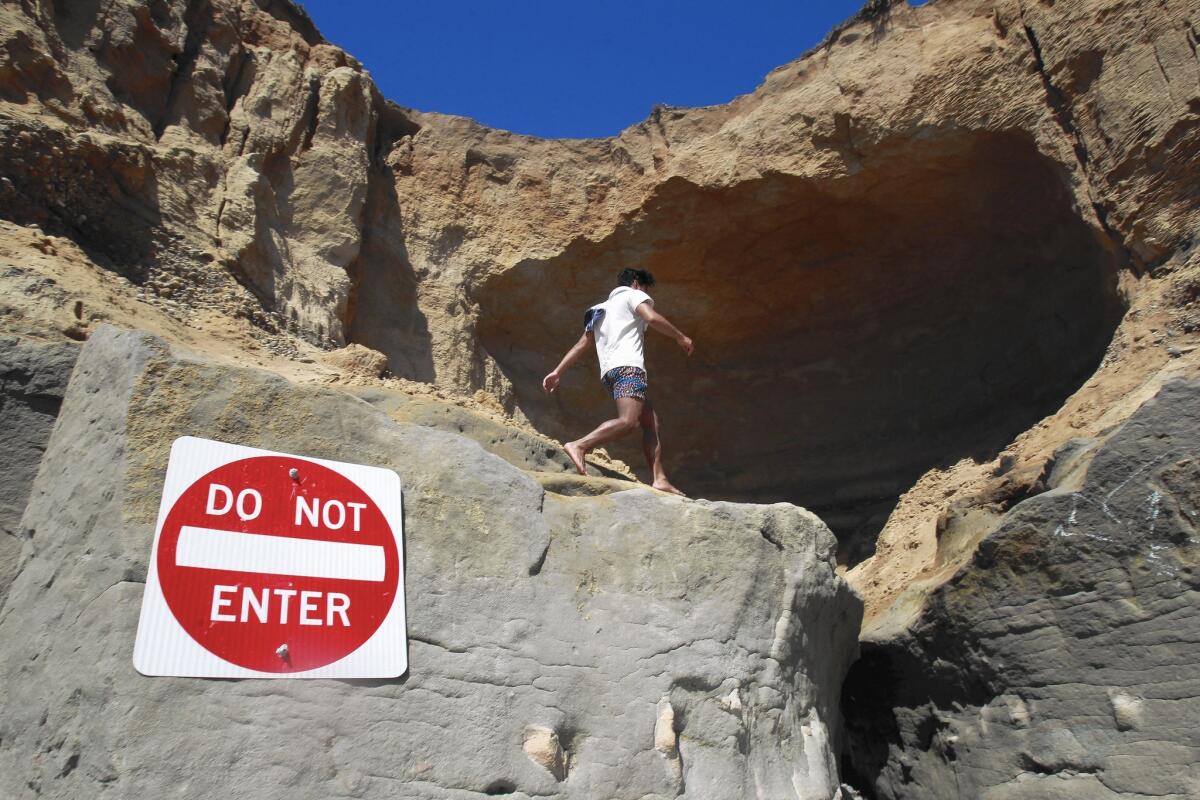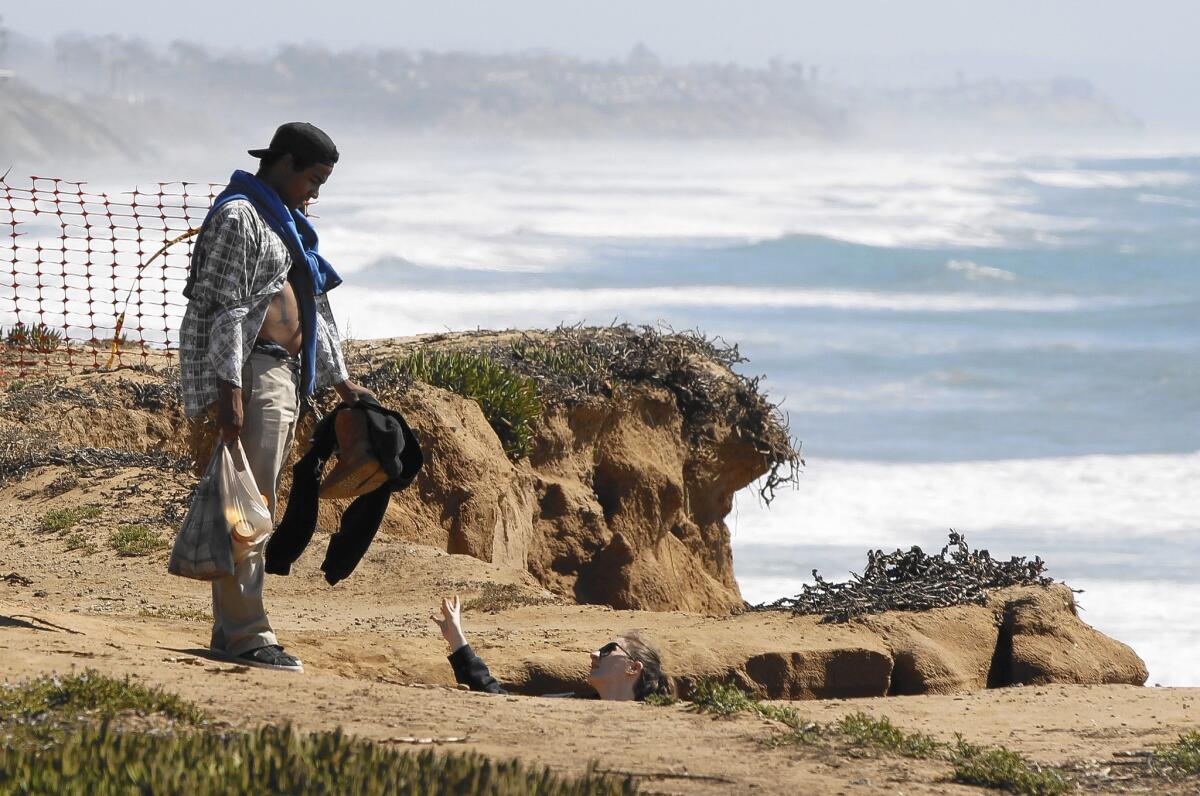Huge sea cave beneath Carlsbad bluff is latest danger along San Diego County’s coastline

Steven Balubar walks near a sea cave that has opened up beneath a Carlsbad bluff. The cave — in the city’s Terramar area — has prompted authorities to post warning signs and cordon off the top of the cliff.
A huge sea cave that has opened beneath a Carlsbad bluff is the latest danger looming along San Diego County’s coastline, which has been battered this winter by high tides and big waves.
The cave — south of Cannon Road in the city’s Terramar area — is about 25 feet wide, 25 feet tall and 15 feet deep, and it has prompted authorities to post warning signs and cordon off the top of the bluff about 50 feet from its edge.
Additional signs are posted below, at the mouth of the cave, but that might not be enough. The area is popular with joggers and visitors who venture onto the cliff to watch the sunset. Below, curious visitors who approach the cave ignore or are oblivious to the danger.
Similar problems have emerged from Torrey Pines to San Onofre, where waves have caused significant erosion, portions of cliffs and bluffs have collapsed and at least two sections of Coast Highway 101 have needed storm-related repairs.

A couple climb down to the beach next to a section of bluff that has eroded in Carlsbad.
“We’re all running from emergency to emergency,” said Robin Greene, superintendent of the San Diego office of the California Department of Parks and Recreation.
State parks officials are considering a number of ideas to deal with the hazard in Carlsbad, Greene said, including using explosives, cables, inflatable wedge bags or high-pressure hoses to tear down the cave before it collapses.
Park workers used cables earlier this year to pull down a large chunk of sandstone bluff at Torrey Pines State Reserve that was threatening to fall on a heavily traveled portion of a trail.
See more of our top stories on Facebook >>
The state parks agency would much rather allow Mother Nature to run its course, Greene said, but after consulting with geologists and other experts, officials decided they had to intervene at Torrey Pines to maintain public safety.
“The best way to handle [an undermined bluff] is to keep people away from it, so that when nature takes its course no one is affected,” she said. “The problem is that people ... make poor choices.”
That’s what’s happening at the Carlsbad site. Besides stepping over the caution tape at the top of the cliff, some visitors have entered the massive cave to carve messages in the soft sandstone.
A collapse would rain down tons of sand on anyone standing above or below — and certainly anyone inside. Several people have been killed by bluff collapses in San Diego County in recent decades. On Jan.16, 2000, a woman sitting below a bluff was crushed while her husband surfed in Encinitas.
This season’s punishing waves have increased the danger.
A big chunk of Sunset Cliffs — between Adair Street and Sunset Cliffs Natural Park in Point Loma — collapsed onto the beach in February, a few weeks after cracks developed in the nearby parking lot. The entire area was cordoned off for safety reasons. No one was injured.
In Solana Beach — which has 1.7 miles of coastline, almost entirely lined by bluffs — El Niño waves have caused the beach to shrink, forcing people to walk closer to the base of the bluffs. That’s exactly where they shouldn’t be, officials said.
“The big thing for us [this winter] was just the loss of sand, like everybody else,” said Craig Miller, captain of the city’s lifeguards. “Our sand levels are really down.”
Miller said his lifeguards frequently warn people to stay back from the bluffs because of the danger that something might fall on them.
Several tons of sandstone fell onto Swami’s Beach in Encinitas in late January. No one was hurt, but Encinitas lifeguards spent the next few days warning people to stay away from the foot of the cliffs.
Encinitas lifeguard Capt. Larry Giles estimated at the time that his employees contact about 4,000 people a year about getting too close to the bluffs.
With so many tall bluffs along the coast, it would be impossible to post signs everywhere warning of a potential collapse. Enforcement is another problem.
“We would need a whole police force” to stop people from entering dangerous areas, said Greene, the state parks official.
“Our general take on this is that the coast is always hazardous,” she said. “Even just a softball-sized rock can be devastating falling from a 50-foot cliff.”
Carlsbad’s beaches are patrolled by state lifeguards, but the city’s firefighters respond to medical emergencies along the city’s seven miles of coastline. Carlsbad Fire Chief Mike Davis said he’s working with the state parks department to keep the beaches safe.
“The actual incidents of bluff failures that cause injuries or fatalities are rare,” Davis said. “They’re very infrequent, and we want to keep it that way.”
Davis said the state is taking the lead on what should be done about the Carlsbad cave, but city officials stand ready to help.
“This is a really challenging one,” Davis said. “It’s a balancing act, whether to step in or not.”
philip.diehl@sduniontribune.com
ALSO
What’s ahead for bullet train funding? Hearing outlines the many risks
Report finds flaws in L.A. County’s system for defending children accused of crimes
Former San Diego mayor was ‘creepy,’ but woman didn’t feel harassed, co-worker testifies
More to Read
Start your day right
Sign up for Essential California for news, features and recommendations from the L.A. Times and beyond in your inbox six days a week.
You may occasionally receive promotional content from the Los Angeles Times.






